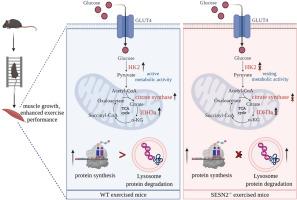SESN2 mediates resistance training-induced improvements in exercise performance and energy metabolism in C57BL/6J mice
IF 3.5
3区 生物学
Q3 CELL BIOLOGY
引用次数: 0
Abstract
Long-term resistance training promotes skeletal muscle hypertrophy and boosts energy metabolism. The stress-inducible protein, SESN2 is a mediator of aerobic training benefits. However, whether SESN2 mediates resistance training to promote skeletal muscle hypertrophy and energy metabolism remains elusive. In this study, eight-week-old C57BL/6J male wild-type (WT) and SESN2−/− mice were subjected to resistance training intervention for 12 weeks. Our results revealed that SESN2 deficiency weakened the effects of resistance training on the increase of grip strength, maximum load capacity, time to exhaustion, and grid suspension time. SESN2 promoted skeletal muscle hypertrophy by inhibiting protein degradation in response to resistance training. Moreover, SESN2 ablation blocked the resistance training-induced improvements in oxygen consumption, carbon dioxide production and energy expenditure. Glycolysis and tricarboxylic acid cycle in skeletal muscle of SESN2−/− mice remain unchanged after resistance training. Furthermore, SESN2 deletion did not alter the expression of key metabolic enzymes in glycolysis and tricarboxylic acid cycle in both atrophied skeletal muscle and resistance exercise preconditioned muscle. These results imply that the SESN2 is a crucial regulator in facilitating the beneficial effects of resistance training on exercise performance, skeletal muscle mass and energy metabolism. This study contributes to the understanding of the mechanisms by which resistance training promotes skeletal muscle energy metabolism.

SESN2介导C57BL/6J小鼠阻力训练诱导的运动表现和能量代谢改善
长期抗阻训练促进骨骼肌肥大,促进能量代谢。应激诱导蛋白SESN2是有氧训练益处的中介。然而,SESN2是否介导阻力训练促进骨骼肌肥大和能量代谢尚不清楚。在这项研究中,8周龄的C57BL/6J雄性野生型(WT)和SESN2 - / -小鼠进行了12周的阻力训练干预。结果表明,SESN2缺乏削弱了阻力训练对握力、最大负载能力、衰竭时间和网格暂停时间的影响。SESN2通过抑制蛋白质降解促进骨骼肌肥厚,以应对阻力训练。此外,SESN2消融阻断了阻力训练诱导的氧气消耗、二氧化碳产生和能量消耗的改善。SESN2 - / -小鼠骨骼肌糖酵解和三羧酸循环在阻力训练后保持不变。此外,SESN2缺失并未改变萎缩骨骼肌和阻力运动预处理肌中糖酵解和三羧酸循环关键代谢酶的表达。这些结果表明,SESN2是促进阻力训练对运动表现、骨骼肌质量和能量代谢的有益作用的关键调节因子。这项研究有助于理解阻力训练促进骨骼肌能量代谢的机制。
本文章由计算机程序翻译,如有差异,请以英文原文为准。
求助全文
约1分钟内获得全文
求助全文
来源期刊

Experimental cell research
医学-细胞生物学
CiteScore
7.20
自引率
0.00%
发文量
295
审稿时长
30 days
期刊介绍:
Our scope includes but is not limited to areas such as: Chromosome biology; Chromatin and epigenetics; DNA repair; Gene regulation; Nuclear import-export; RNA processing; Non-coding RNAs; Organelle biology; The cytoskeleton; Intracellular trafficking; Cell-cell and cell-matrix interactions; Cell motility and migration; Cell proliferation; Cellular differentiation; Signal transduction; Programmed cell death.
 求助内容:
求助内容: 应助结果提醒方式:
应助结果提醒方式:


